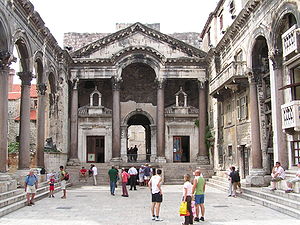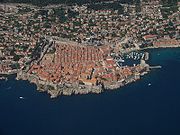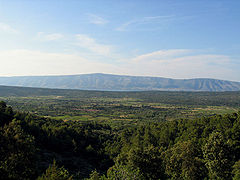
World Heritage Sites in Croatia
Encyclopedia
World Heritage Sites
| Image | Name | Location | UNESCO data | Description |
|---|---|---|---|---|
| Plitvice Lakes National Park | Plitvička Jezera Plitvicka Jezera Plitvička Jezera is a municipality in central Croatia, in the eastern part of the Lika-Senj county, that lies in and near the eponymous Plitvice Lakes National Park, bisected by the D1 main road . Its total area is 539.08 km². The main town and seat of the municipality is Korenica... |
Over time, water has flown over the natural limestone Limestone Limestone is a sedimentary rock composed largely of the minerals calcite and aragonite, which are different crystal forms of calcium carbonate . Many limestones are composed from skeletal fragments of marine organisms such as coral or foraminifera.... and chalk, creating natural dams which in turn have created a series of connecting lakes, waterfalls, and caves. The nearby forests are home to bears, wolves and many rare bird species. |
||
 |
Historical Complex of Split Split (city) Split is a Mediterranean city on the eastern shores of the Adriatic Sea, centered around the ancient Roman Palace of the Emperor Diocletian and its wide port bay. With a population of 178,192 citizens, and a metropolitan area numbering up to 467,899, Split is by far the largest Dalmatian city and... with the Palace of Diocletian Diocletian's Palace Diocletian's Palace is a building in Split, Croatia, that was built by the Roman emperor Diocletian at the turn of the fourth century AD.Diocletian built the massive palace in preparation for his retirement on 1 May 305 AD. It lies in a bay on the south side of a short peninsula running out from... |
Split Split (city) Split is a Mediterranean city on the eastern shores of the Adriatic Sea, centered around the ancient Roman Palace of the Emperor Diocletian and its wide port bay. With a population of 178,192 citizens, and a metropolitan area numbering up to 467,899, Split is by far the largest Dalmatian city and... |
The palace was built by the Roman emperor Roman Emperor The Roman emperor was the ruler of the Roman State during the imperial period . The Romans had no single term for the office although at any given time, a given title was associated with the emperor... Diocletian Diocletian Diocletian |latinized]] upon his accession to Diocletian . c. 22 December 244 – 3 December 311), was a Roman Emperor from 284 to 305.... at the turn of the fourth century AD, and later served as the basis of the city of Split. A cathedral was built in the Middle Ages inside the ancient mausoleum, along with churches, fortifications, Gothic and Renaissance palaces. The Baroque style makes up the rest of the area. |
|
 |
Old City of Dubrovnik Dubrovnik Dubrovnik is a Croatian city on the Adriatic Sea coast, positioned at the terminal end of the Isthmus of Dubrovnik. It is one of the most prominent tourist destinations on the Adriatic, a seaport and the centre of Dubrovnik-Neretva county. Its total population is 42,641... |
Dubrovnik Dubrovnik Dubrovnik is a Croatian city on the Adriatic Sea coast, positioned at the terminal end of the Isthmus of Dubrovnik. It is one of the most prominent tourist destinations on the Adriatic, a seaport and the centre of Dubrovnik-Neretva county. Its total population is 42,641... |
Dubrovnik became a prosperous Maritime Republic during the Middle Ages Middle Ages The Middle Ages is a periodization of European history from the 5th century to the 15th century. The Middle Ages follows the fall of the Western Roman Empire in 476 and precedes the Early Modern Era. It is the middle period of a three-period division of Western history: Classic, Medieval and Modern... , it became the only eastern Adriatic city-state City-state A city-state is an independent or autonomous entity whose territory consists of a city which is not administered as a part of another local government.-Historical city-states:... to rival Venice Venice Venice is a city in northern Italy which is renowned for the beauty of its setting, its architecture and its artworks. It is the capital of the Veneto region... . Supported by its wealth and skilled diplomacy Diplomacy Diplomacy is the art and practice of conducting negotiations between representatives of groups or states... , the city achieved a remarkable level of development, particularly during the 15th and 16th centuries. |
|
| Episcopal Complex of the Euphrasian Basilica Euphrasian Basilica The Euphrasian Basilica is a basilica in Poreč, Croatia. The episcopal complex, including, apart the basilica itself, a sacristy, a baptistery and the bell tower of the nearby archbishop's palace, is one of the best examples of early Byzantine architecture in the Mediterranean region.The... in the Historic Centre of Poreč Porec Poreč is a town and municipality on the western coast of the Istrian peninsula, in Istria County, Croatia. Its major landmark is the 6th century Euphrasian Basilica, a UNESCO World Heritage Site since 1997.... |
Poreč Porec Poreč is a town and municipality on the western coast of the Istrian peninsula, in Istria County, Croatia. Its major landmark is the 6th century Euphrasian Basilica, a UNESCO World Heritage Site since 1997.... |
The episcopal complex, with its striking mosaics dating back to the 6th century, is one of the best examples of early Byzantine art Byzantine art Byzantine art is the term commonly used to describe the artistic products of the Byzantine Empire from about the 5th century until the Fall of Constantinople in 1453.... and architecture in the Mediterranean region and the world. It includes the basilica itself, a sacristy, a baptistery and the bell tower of the nearby archbishop's palace. |
||
| Historic city of Trogir Trogir Trogir is a historic town and harbour on the Adriatic coast in Split-Dalmatia County, Croatia, with a population of 12,995 and a total municipality population of 13,322 . The historic city of Trogir is situated on a small island between the Croatian mainland and the island of Čiovo... |
Trogir Trogir Trogir is a historic town and harbour on the Adriatic coast in Split-Dalmatia County, Croatia, with a population of 12,995 and a total municipality population of 13,322 . The historic city of Trogir is situated on a small island between the Croatian mainland and the island of Čiovo... |
Trogir's rich culture was created under the influence of old Greeks, Romans, and Venetians. It is the best-preserved Romanesque-Gothic Gothic architecture Gothic architecture is a style of architecture that flourished during the high and late medieval period. It evolved from Romanesque architecture and was succeeded by Renaissance architecture.... complex not only in the Adriatic, but in all of Central Europe Central Europe Central Europe or alternatively Middle Europe is a region of the European continent lying between the variously defined areas of Eastern and Western Europe... . Trogir's medieval core, surrounded by walls, comprises a preserved castle and tower and a series of dwellings and palaces from the Romanesque, Gothic, Renaissance and Baroque periods. |
||
| Cathedral of Saint James Cathedral of St. James, Šibenik The Cathedral of St. James inŠibenik, Croatia is a triple-nave basilica with three apses and a dome in the city of Šibenik, Croatia. It is the church of the Catholic Church in Croatia, and the see of the Šibenik diocese. It is also the most important architectural monument of the Renaissance in... |
Šibenik Šibenik Šibenik is a historic town in Croatia, with population of 51,553 . It is located in central Dalmatia where the river Krka flows into the Adriatic Sea... |
The cathedral is a triple-nave basilica Basilica The Latin word basilica , was originally used to describe a Roman public building, usually located in the forum of a Roman town. Public basilicas began to appear in Hellenistic cities in the 2nd century BC.The term was also applied to buildings used for religious purposes... with three apses and a dome (32 m high inside) and is also one of the most important architectural monument of the Renaissance Renaissance The Renaissance was a cultural movement that spanned roughly the 14th to the 17th century, beginning in Italy in the Late Middle Ages and later spreading to the rest of Europe. The term is also used more loosely to refer to the historical era, but since the changes of the Renaissance were not... the eastern Adriatic. |
||
 |
Stari Grad Plain Stari Grad Plain The Stari Grad Plain on the island of Hvar is an agricultural landscape that was set up by the ancient Greek colonists in the 4th century BC, and remains in use today. The plain is generally still in its original form... |
Hvar Hvar - Climate :The climate of Hvar is characterized by mild winters and warm summers. The yearly average air temperature is , 686 mm of precipitation fall on the town of Hvar on average every year and the town has a total of 2800 sunshine hours per year. For comparison Hvar has an average of 7.7... |
The Stari Grad Plain is an agricultural landscape that was set up by the ancient Greek colonists Colonies in antiquity Colonies in antiquity were city-states founded from a mother-city—its "metropolis"—, not from a territory-at-large. Bonds between a colony and its metropolis remained often close, and took specific forms... in the 4th century BC, and remains in use today. The plain is generally still in its original form. The ancient layout has been preserved by careful maintenance of the stone walls over 24 centuries. |
Tentative List
The following sites are on the Tentative List for Croatia, meaning that the government intends to consider them for nomination in the future:- Zadar - Episcopal complex
- StonStonSton is a village and municipality in the Dubrovnik-Neretva County of Croatia, located at the south of isthmus of the Pelješac peninsula. The town of Ston is the center of the Ston municipality.- Demographics :...
- Historical town planning ensemble of Ston with Mali Ston, connecting wallsWalls of StonThe Walls of Ston are a series of defensive stone walls, originally more than long, that surrounded and protected the city of Ston, in Dalmatia, part of the Republic of Ragusa, in what is now southern Croatia....
, the Mali Ston Bay nature reserve, Stonsko Polje and the salt pans - Tvrđa in OsijekOsijekOsijek is the fourth largest city in Croatia with a population of 83,496 in 2011. It is the largest city and the economic and cultural centre of the eastern Croatian region of Slavonia, as well as the administrative centre of Osijek-Baranja county...
-Historical Town Planning Ensemble - VarazdinVaraždinVaraždin is a city in north Croatia, north of Zagreb on the highway A4. The total population is 47,055, with 38,746 on of the city settlement itself . The centre of Varaždin county is located near the Drava river, at...
- Historic Nucleus and Old Town (the Castle) - Veliki Tabor Castle
- Lonjsko PoljeLonjsko PoljeLonjsko Polje is the largest protected wetland in both Croatia and the entire Danube basin. It covers an area of , extending along the river Sava from the areas east of Sisak, the lower course of the river Lonja for which it is named, to the areas west of Nova Gradiška, along the course of the...
Nature Park - VelebitVelebitVelebit is the largest though not the highest mountain range in Croatia. Its highest peak is the Vaganski vrh at 1757 m.The range forms a part of the Dinaric Alps and is located along the Adriatic coast, separating it from Lika in the interior...
Mountain - Frontiers of the Roman Empire Croatian Limes-stretching from Batina Skela to IlokIlokIlok is the easternmost town and municipality in Croatia. Located in the Syrmia region, it lies on a hill overlooking the Danube river, which forms the border with the Vojvodina region of Serbia. The population of the town of Ilok is 5,036, while the total municipality population is 6,750...
- LubeniceLubeniceLubenice is an ancient fort city on the island of Cres, Croatia that was founded approximately four thousand years ago on top of a 380 m high ridge that overlooks the Adriatic Sea. It is a small local center that comprises forty buildings and twenty-four permanent inhabitants...
-Historical town in CresCresCres is an Adriatic island in Croatia. It is one of the northern island in the Kvarner Gulf and can be reached via ferry from the island Krk or from the Istrian peninsula .... - PrimoštenPrimoštenPrimošten is a town in Croatia, and a part of the Šibenik-Knin County. It is situated in the south, between the cities of Šibenik and Trogir, on the Adriatic coast. 97.03% of the citizens are Croats.-History:...
Vineyards - Hermitage Blaca on the island of BračBracBrač is an island in the Adriatic Sea within Croatia, with an area of 396 km², making it the largest island in Dalmatia, and the third largest in the Adriatic. Its tallest peak, Vidova Gora, or Mount St. Vid, stands at 778 m, making it the highest island point in the Adriatic...
- City of MotovunMotovunMotovun is a village in central Istria, Croatia. The population of the village itself is 531, with a total of 983 residents in the municipality ; 442 of the residents have Italian as their mother language...
- The historic town of KorčulaKorculaKorčula is an island in the Adriatic Sea, in the Dubrovnik-Neretva County of Croatia. The island has an area of ; long and on average wide — and lies just off the Dalmatian coast. Its 16,182 inhabitants make it the second most populous Adriatic island after Krk...
- Kornati National ParkKornatiThe Kornati archipelago in Croatia is located in the northern part of Dalmatia, west from Šibenik, in the Šibenik-Knin county. With 35 km in length and 140 islands, some large, some small, in a sea area of about 320 km², Kornati are the densest archipelago in the Mediterranean Sea...
and TelašćicaTelašćicaTelašćica is a bay that is situated in the southeastern portion of the island of Dugi Otok, Croatia in the Adriatic Sea. It is a designated nature park, full of wildlife and sea creatures.-Geography:...
Nature Park
See also
- World Heritage SiteWorld Heritage SiteA UNESCO World Heritage Site is a place that is listed by the UNESCO as of special cultural or physical significance...
- Register of Protected Natural Values of CroatiaRegister of Protected Natural Values of CroatiaThe Register of Protected Natural Values of the Republic of Croatia has been created according to the Nature Protection Act in 2005 . The register is being administered by the Administration for Nature Protection within the Croatian Ministry of Culture...
- Register of Cultural Goods of CroatiaRegister of Cultural Goods of CroatiaThe Register of Cultural Goods of the Republic of Croatia has been established in 1999. The Croatian Ministry of Culture is responsible for the administration of this public register, which has been created according to the Act on the protection and preservation of cultural goods of 1999...
- UNESCO Intangible Cultural Heritage Lists

